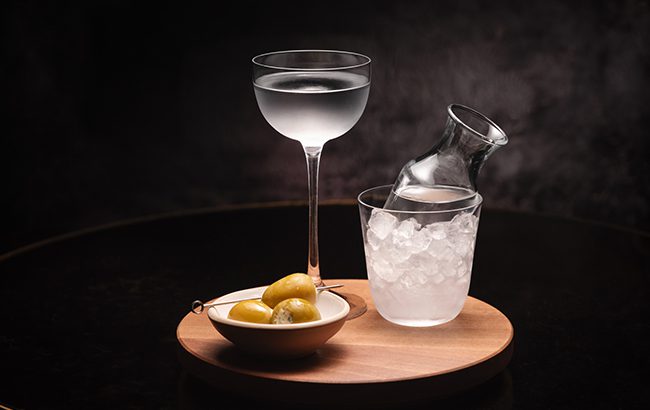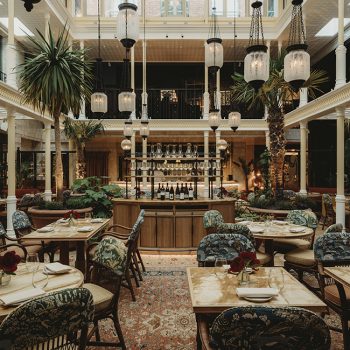Twenty8 Nomad’s love letter to the Martini
By Lauren BowesAt Twenty8 Nomad, the restaurant and bar at London’s Nomad Hotel that opens today (9 May), the Martini is the star of the show.

Led by vice-president of food and beverage Leo Robitschek, the drinks programme reflects the hotel’s proud New York heritage. “When we decided to do Twenty8, we really thought about who we were and the fabric of who we are,” explains Robitschek.
Robitschek grew up in New York City with Nomad London’s executive chef Zak Gregoire and culinary director Bryce Shuman, working together at venues from Eleven Madison Park through to Nomad. “Nomad is very much a New York brand. Coming here [to London] and doing anything else felt a little disingenuous. We wanted to honour what we grew up eating, drinking and cooking in New York City, where we all got our start,” says Robitschek.
The middle section of the menu consists of cocktails that ‘shaped New York’s modern cocktail renaissance’. That, of course, means iconic serves like the Cosmopolitan, the Clover Club and Penicillin, with the menu paying tribute to their creators.
The final section, labelled ‘Proprietary Cocktails’, features classics – with a Nomad twist, of course. The Negroni is twisted with flavours of a guava and cheese pastry, inspired by New York’s Puerto Rican diaspora, while the Tequila Sour reflects the legacy of Italian-Americans in Brooklyn through Caprese notes.
But the menu opens with the bar’s dedicated Martini menu, which focuses on the cocktail’s enduring appeal.

For Robitschek, the Martini links London and New York perfectly: “I don’t think there’s a better beverage that defines that than the Martini. Both London and New York take a lot of ownership over it. And it holds true to my heart. It’s one of my favourite drinks.”
The story of the Martini
The Martini’s evolution begins, as Robitschek tells it, with the Manhattan. “Most people don’t realise that the Martini came from the Manhattan,” he explains.
The Manhattan has myriad origin stories. Robitschek’s favourite version is that it was created for presidential candidate Samuel Tilden, who was holding a fundraiser at the Manhattan Club in 1874. One guest, Jennie Jerome, requested a special cocktail to honour the event. “While it’s a beautiful story, we know it can’t be fully true. Jennie Jerome is also known as Jennie Churchill, and she was actually giving birth to Sir Winston Churchill in London during that time,” he laughs.
Later in the 1800s, Jerry Thomas swapped rye whiskey for gin, creating the Martinez – the father of the Martini. Eventually, the sweet vermouth was switched to dry, creating what we know now as the modern-day Martini.
“Then it just got drier and drier,” Robitschek says. The increase in dryness could be attributed to Prohibition and the surprise entrance of vodka, he explains. The end of Prohibition created a generation of people who didn’t know how to drink, which gave vodka an opportunity. “Before then, whiskey, rum and gin were the things people would drink. But it was easier to sell something drier and with less flavour to the generation that started drinking again,” he says.
The Nomad take
The menu covers Martinis from all angles, so choosing just one to be the bar’s namesake was no mean feat. The Twenty8 Martini channels the restaurant’s classic NY steakhouse theme. Robitschek explains: “I wanted to take something nostalgic – like when you go to a Keens [Steakhouse] and have a 180ml Martini that is maybe not executed in the best way, but it is still fun to see this massive cup, with these big olives. I wanted to refine it in a version that still has the nostalgia but also tastes delicious.”
The refinement involves smoking Gordal olives, which the team use to create a house-made olive brine using vermouth, white balsamic vinegar, salt and water. This smoky brine is combined with Grey Goose vodka and blanc vermouth, then washed with olive oil to “mellow it out”. It is served, of course, with blue cheese-stuffed olives.

While Robitschek describes himself as a purist, he thinks there’s still room to be creative with Martinis. “They’re super-simple drinks in their build, but they’re really hard to do exceptionally well. There’s no hiding in them,” he says. “It’s about honouring those three or four ingredients as much as we can, but also being a bit playful and maybe modifying a few of them.”
One such example is the Walter Gibson, which was created for Nomad’s former wine director Thomas Pastuszak and named after his son. The idea was to create flavours of Chenin Blanc, Pastuszak’s favourite grape variety. A dessert Chenin Blanc features in the cocktail, as well as vodka, gin, vermouth and Sherry. Pear eaux-de-vie adds an “orchard fruit quality”. The cocktail is then aged in beeswax, “to give it that waxy texture Chenin Blanc has”.
And why is the Martini in resurgence? Robitschek says: “It’s never really gone away. But while the world of drinking has contracted, it’s also expanded. People might be drinking less wine, less straight spirits and less beer, but I think people are drinking more craft cocktails.
“While they’re drinking less, they want a better-crafted cocktail because it’s not something they could really make at home.
“It’s also a drink that people know is simple in its appearance, but also very hard to perfect, so people go out and seek it.
“You feel celebratory when you have a Martini in hand – there’s no better way to do that than with a Martini.”
Related news
UK on-trade business rates to jump 76% by 2028
